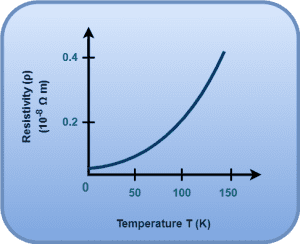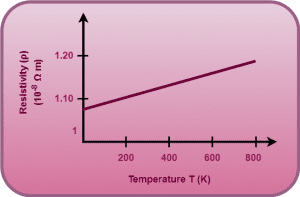Resistivity-
Before you go through this article, make sure that you have gone through the previous article on Resistivity of Conductor.
We have learnt-
- Resistivity of a conductor is defined as the resistance of a unit cube of the material of the conductor.
- It depends upon the nature of material and temperature of the conductor.
In this article, we will discuss the temperature dependence of resistivity for-
- Metals
- Alloys
- Semiconductors & Insulators
- Electrolytes
Temperature Dependence of Resistivity-
The resistivity of any material depends upon the number density (n) of free electrons and the mean collision time (τ) as-

Also Read- Deriving Formula For Resistivity of Conductor
For Metals (Conductors)-
- For metals, the number density (n) of free electrons is almost independent of temperature.
- As temperature increases, the thermal speed of the free electrons increases and also the amplitude of vibration of the metal ions increases.
- Consequently, the free electrons collide more frequently with the metal ions.
- Thus, the mean collision time (τ) decreases.
Hence,
|
On increasing the temperature,
the resistivity of metals (conductors) increases. |
For most of the metals, resistivity increases linearly with the rise in temperature.
In such cases, resistivity at any temperature T (>T0) is given by-

where-
- ρT = Resistivity at temperature T
- ρ0 = Resistivity at a reference temperature T0
- α = Temperature coefficient of resistivity
Temperature Coefficient of Resistivity
The temperature coefficient of resistivity (α) may be defined as the increase in resistivity per unit resistivity per unit rise in temperature.
|
For metals, the value of α is positive meaning that the resistivity increases with the increase in temperature.
At low temperatures, the resistivity of metals increases as a higher power of temperature.
The following graph shows the variation of resistivity (ρ) of copper as a function of temperature T-

For Alloys-
- When two or more metals are mixed together to form an alloy, a complex crystalline structure is formed.
- This is because of what alloys have very high resistivity than their constituent metals.
ρalloys > ρmetals
|
Alloys have very weak dependence on temperature.
For alloys, α → 0 |
Example-
The resistivity of nichrome has weak temperature dependence as shown in the following graph while that of manganin is almost independent of temperature.
αalloys < αmetals

For Semiconductors and Insulators-
For semiconductors and insulators, the relaxation time does not change with temperature but the number density (n) of free electrons increases exponentially with the rise in temperature.
Hence,
|
On increasing the temperature, the resistivity of semiconductors and insulators decreases.
Thus, for semiconductors and insulators, α is negative. |
![]()
For Electrolytes-
As the temperature increases, the inter-ionic attractions (solute-solute, solvent-solute and solvent-solvent types) decreases and also the viscous forces decreases and therefore the ions are able to move more freely.
Hence,
|
As the temperature of electrolytic solution increases,
the resistivity of electrolyte decreases. |
Test Your Concepts-
Quiz on Temperature Dependence of Resistivity
Next Article-
Get more notes & other study material of the Chapter Current Electricity.


